08-02-vl-2-crinoid-head-826
Archimedes, horned coral, crinoid head
Archimedes, horned coral, crinoid head
Shell impressions and pieces of cora.
Molds of brachiopods and horned coral.
Back in the car headed to site #2, and it began raining again. Darn! As the drizzle quits, someone suggests a side trip to the lake, to check the water level, and much to our delight, it was way down, so we added an unexpected new stop, where everyone found a number of crinoid stems, blastoids, archimedes, an unknown trace fossil, and horned coral. One comment was "How many days do we get to spend here?". The weather got warmer, and became very pleasant, even without coats (a real thrill to those of us who remember many collecting trips tolerating the icy cold wind that normally whips around the point most of the winter). In keeping with our international flavor, two guests from Japan (who have only been in the US since July) joined us for their first ever-fossil trip. We may have spoiled them. NO you DON'T find fossils on every spot of ground in Alabama!
Then, when Greg was able to tear us away from the lake, on to the next location, site #3, a popular road cut in Colbert County, where nice blastoids, archimedes, and straight cephalopods were found. Also, an outstanding question was answered. On our August 2005 field trip, an odd, lightweight, heart shaped disk was found in Montgomery County that we couldn't identify. On one of Vicki's side excursions today, she found part of a vertebra column, probably of a deer, and several of the heart-shaped cartilage discs were found in place. Now we know - not a fossil, but very interesting.
The 4th stop had a few specimens, but not enough to linger.
At that point, part of the group went to an additional site, where there were nice fossils, mostly still in matrix. This site contains metallic, cubic mineral specimens that have not yet been positively identified. They look similar to pyrite, but are the wrong shape and color. They are small, about 1/4 inch, cubic, shiny reddish-gold copper colored, and heavy for their size. The square sides aren't exactly straight, since they have a dip in the middle. They could possibly be limonite after pyrite.
After that, the entire group met up again, and headed to an off-the-beaten-path steak house in the middle of nowhere to wind down for the evening and enjoy each other's good company before starting the long trip back home.
(photos courtesy Lea Martin and Vicki Lais)
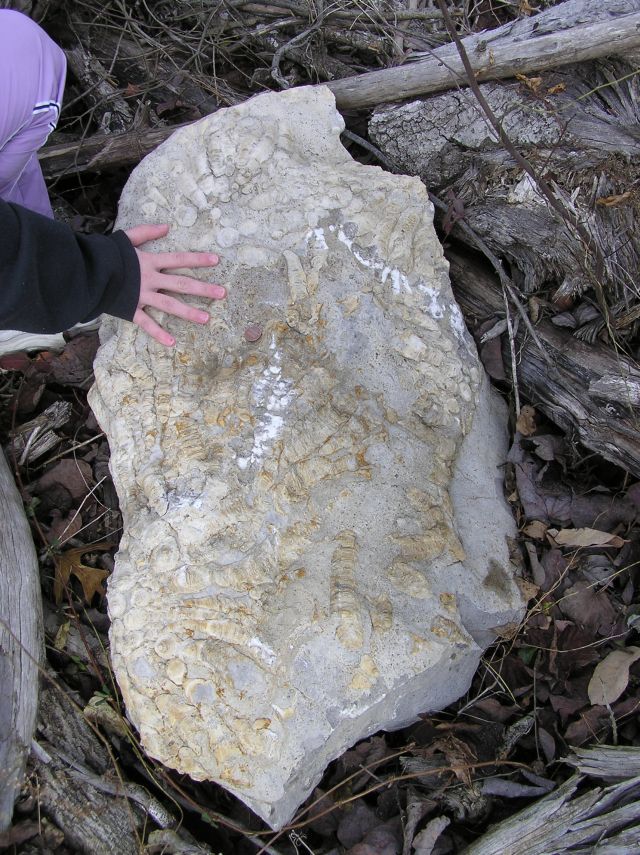
The first stop produced very large specimens of rugose coral, most too large to carry.

Leisa, our Pres, and new members Hitoshi and Yakari on their first fossil trip... Welcome to Alabama!

Paige just needs her picture taken since she is so photogenic. What a nice specimen of coral she's found!

Jan and Greg searching for loose corals.

One of the nicest specimens.
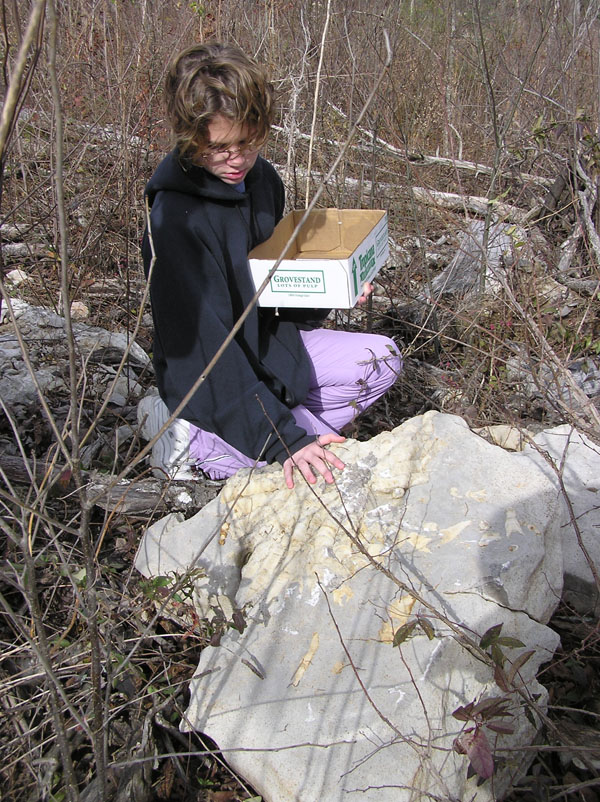
Uh.... Paige..... I don't think it will fit in your box......


Lea Novak has lugged this large coral to her car.
On to site #2 -

Most of the rocks on this lakeshore are filled with small fossils. Most plentiful are crinoids, blastoids, archimedes, and horned corals.
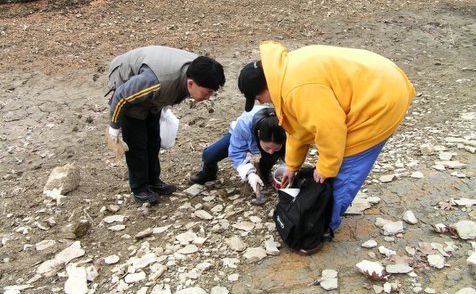
Leisa showing our newest members fossil specimens on the rocks.

Greg has found a nice slab to show how plentiful fossils are in this area.

Every rock here is covered with fossils. So why search? Some rocks have weathered more than others, and the fossils are in nice relief. Some have more "perfect" examples, some have more of the "pretty" fossils, or displayed a larger variety.


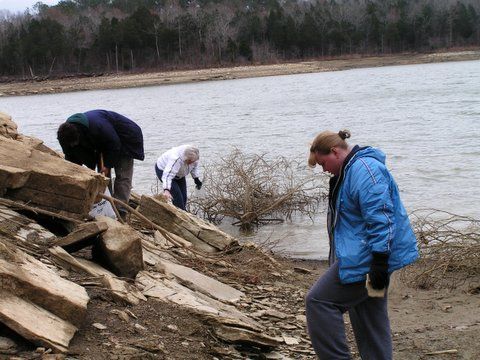
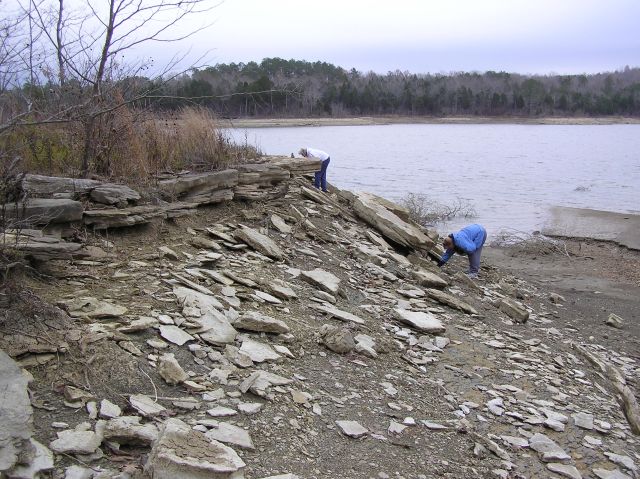

Melanie has found a nice.... well....umm.... trace fossil??
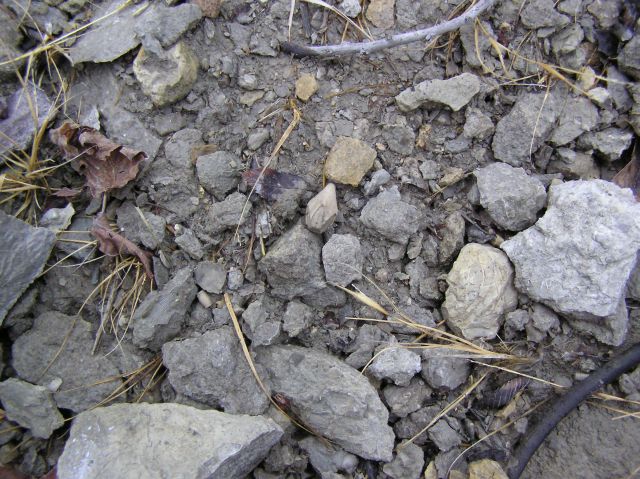
Look carefully in the middle of the photograph to see a blastoid.

Closer view of blastoids.

Hi, Claire!

Hard to see, but this boulder is covered with very tiny crinoids, probably a breeding area.
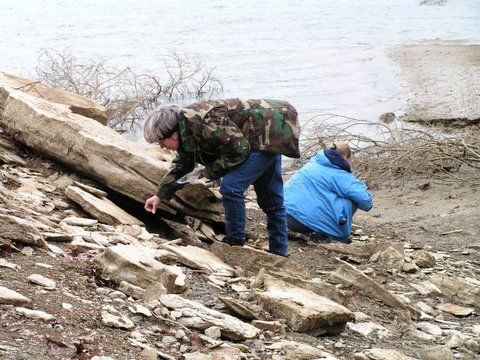
Stop #3 is a roadcut -
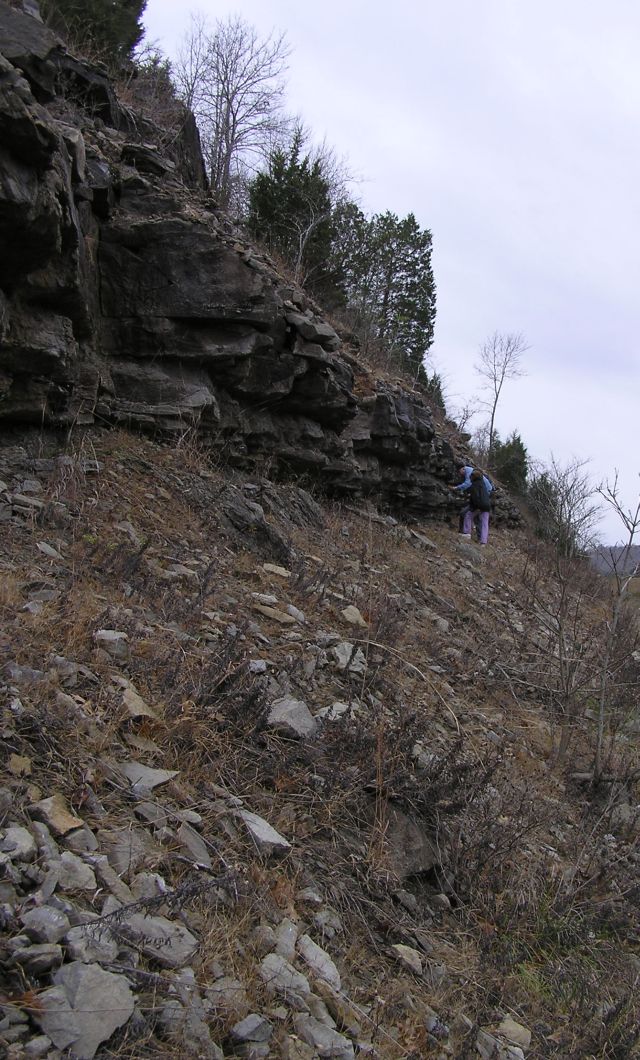
Blastoids, horned coral, and archimedes were found in this area.


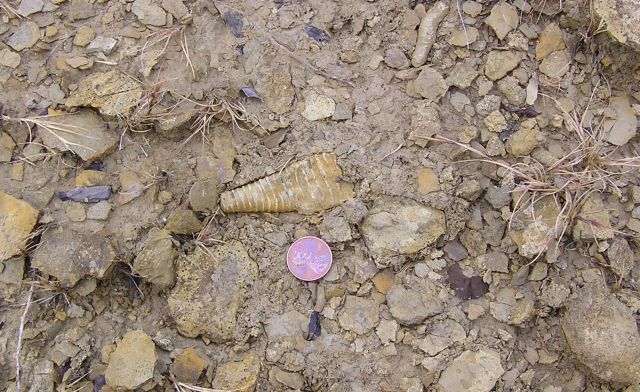
A few straight cephalopods were also found.
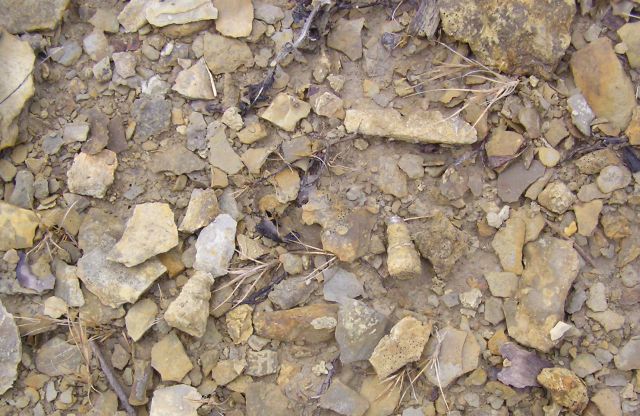
Some fairly worn specimens of horned coral.
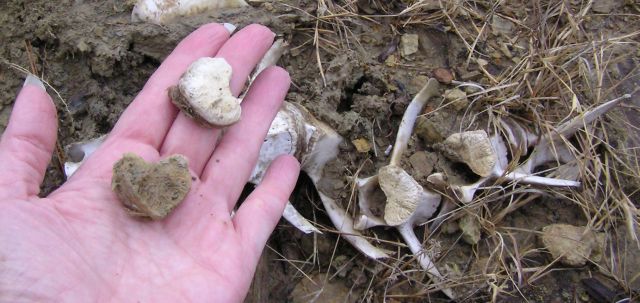
Another mystery solved. A heart shaped item had been found on our Montgomery trip, but no one knew what it was. Several of them were found in place today - in a deer spine. They are the discs between vertebra.
Stop #4 - another wash in a roadcut.

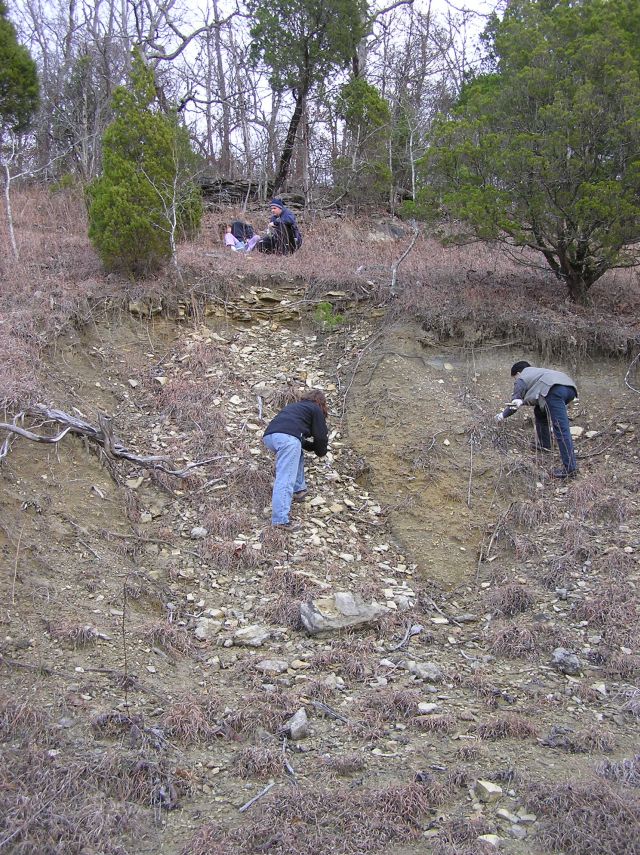
Very little was found at this location, but we had fun looking!
While most of the group headed for the local watering hole, 3 members proceeded on to stop #5:

A beautiful layer of bivalves is now exposed. Impossible to collect without damaging the specimens, so we collected only photos.

A closer view after cleaning. They are heavy, and may be pyrite. Possibly limonite after pyrite.
This month, BPS visited the "education center" of a local Jefferson County quarry, where school children are taught about quarry operations in a nice building with a great view of the quarry, and a small working model of the conveyor activity. Inside, there were numerous fossil displays exhibiting fossils from many of their quarry locations around the south. Upon seeing several whole crinoids on display, we were practically drooling to get going on the collecting trip. The group then drove to a quarry in Morgan County, Alabama. This was a site where no one had collected before, other than quarry personnel, and what a fine group of specimens were found! Large blastoids, crinoids, horned coral, and archimedes were our primary finds. At least 6 whole crinoids were found, and the excitement of the members upon finding yet another of these wonderful specimens was very exciting! Due to the unusually chilly, overcast weather as compared to the prior few weeks, no rattlesnakes were spotted, though our leader said he had encountered 4 of them last summer.
(Photos courtesy Ron Beerman, Bill Cunningham, Greg Mestler & Vicki Lais.)

Several whole crinoids were found on the trip; this one by Vicki.

Several BPS members diligently searching the spoil piles.

Greg dissolved a slab of limestone he took home and found these crinoids inside.

Numerous blastoids, crinoid parts, and horned coral were found.

Crinoids found by Jan and Claire.

Found by Ron.

Found by Bill.

The view from the collecting site.

Outcrop of rugosa coral.

Found by Ron.

Bill and Adele in foreground, Leisa in background.


Looking in all the cracks and crevices.

More of Ron's finds.
Our third stop of the day was at a roadcut in Lawrence County, Alabama, where numerous specimens of rugosa coral, including whole coral heads the size of boulders, were found. There was even a small cave-like cavity in the ground that had been uncovered, where one could peer in and see a small, undisturbed area of coral in place. Both collecting sites were in the Bangor Limestone.

More rugosa coral, from the second site of the day.
We visited two late Cretaceous sites in Montgomery County, Alabama, where we collected primarily shark teeth and echinoids. A surprise awaited - one site we have visited for years used to have a huge sand pile shaped like a mushroom that was filled with shark teeth. The mushroom is no more, and all that is left is a sandpile. Last we heard, the sand was being used in the zoo. You don't want to know any more than that!
(Photos courtesy Brian Ward.)
|
This Saturday field trip was the first visit even by veteran BPS members to a quarry located in north Bibb County. The rocks from this quarry have been used as rip-rap at several highway locations, the best ones I know of being on a ramp at Exit 79 and between Exits 77 and 79 on I20/59 near Tuscaloosa. |
The trip was attended by 20-25 BPS members and guests on the first rainy day we had in nearly three weeks. This quarry is a largely abandoned location where rocks of middle Ordovician age (460-480 million years) have been exposed. The rock formations at this site are part of the well known Chickamauga Limestone Group. The main quarry pit is now a small lake filled with deep-looking water having a strong aquamarine color. The lake is surrounded by steep cut cliffs. Rocks are scattered in large piles around a wide area near the lake, and it was among these piles that BPS members searched for fossils of mostly marine animals. In spite of the vastness of the area, it took some tenacity to find fossils since fossiliferous rocks were not that common. |
 |
| Fig. 2 - Group discussing strategy for exploring the area. |
|---|
 |
| Fig. 3 - View towards rock piles around the lake. |
Apparently, it is the fossils themselves that tell us the age of the rocks at this site. According to Prof. Carl Stock of the University of Alabama Department of Geology, the main index fossils are conodonts, which are very small, sometimes cone-like objects whose nature is not well understood. I am not sure that any of us noticed such fossils, but a magnifier would probably be needed to see them in any case. More obvious index fossils found in quarry rocks are brachiopods. According to R. Wixon (University of Alabama master's thesis, 1984), Ordovician brachiopods are good index fossils because of their abundance worldwide and the short period of their evolutionary timescale. Well-preserved brachiopods of clear middle Ordovician age are found at the quarry and at the I20/59 sites.
Many of the brachiopods that we found at the quarry appear to belong to the order Strophomenida which, according to The Fossil Book by Rich, Rich, Fenton, and Fenton (1996), are frequently referred to as "petrified butterflies". There are many genera and species in this order of articulate brachiopods, and I could only identify a few in the rocks that I personally picked up, based on illustrations in Wixon's thesis and Volume H of the Treatise on Invertebrate Paleontology (Moore, editor, 1965). A few are shown in the illustrations here. Larry Hensley found a large slab covered with brachiopod shells mostly about 1 cm in diameter each (see photo). Several of us managed to hammer away at this large rock and get some pieces of it. Many of the brachiopods on this slab appear to be of the genus Sowerbyella. |
 |
| Fig. 6 - Medium-sized brachiopod, probably of genus Rafinesquina, with smaller Hesperorthis australis brachiopods to upper right and left |
|---|
|
Larger brachiopods about 2.5 cm or so in diameter seemed less abundant than the 1cm or smaller pieces. The one I show here, shaped sort of like a tombstone, is probably of the genus Strophomenus or, more likely, Rafinesquina. The largest brachiopod I found is more than 3cm in diameter, and may be of the genus Tetraphalerella, whose members can get this large according to Wixon. Other fossils found include the stems of crinoids, random stem plates of dis-assembled crinoids, bryozoans, parts of trilobites and, I heard, cystoids. Trace fossils of worm burrows were actually among the easiest fossils to find at this site. A large slab covered with criss-crossing tracks is shown here. Don McDonald also showed me what he thought was the end of a horn coral, and Vicki Lais showed several of us a very large rock having some interesting spiral-shaped fossils that we could not identify. Apparently, someone had previously used a rock saw to cut out a piece of this same rock. |
|
|
Although it was not easy finding fossils at this site, it was clear that everyone who attended the field trip had an enjoyable time. The area was interesting and the rocks mysterious, being older than most of those exposed in regions north and south of the site. The key to success at a site like this is to have a lot of time to explore and to be prepared. I regret that I had not studied any of the books I mention above until AFTER I got home! --Edited by Vicki Lais |
|
|
|
|
|
|
|
|
|
|
|